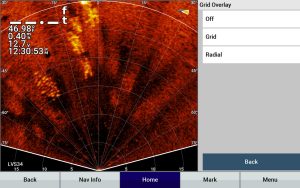Garmin’s Perspective View radial grids look like this without a sonar image. (credit: Brad Wiegmann)
Catch More Fish With Radial Grid Lines
by Brad Wiegmann
Use radial grid lines to see how many feet away from the transducer fish, brush or cover are located.
Everyone goes on and on about catching fish using forward facing sonar (FFS), but it’s almost always about the forward-facing mode. What about other modes? Down mode can be a valuable tool for seeing behind and forward, but it’s the last mode with a wide, flat beam angle with radial grid lines that can help you catch more fish.
Garmin Perspective View, Lowrance Scout mode and Humminbird Landscape Mode are all similar modes with a wide live-action degree angle. The wide-angle view continues as the transducer is pointed and scanned. Distance and depth can be controlled according to where the angler is fishing.
A closer look at Garmin Perspective View reveals an angler can choose from having the grid overlay off, grid or radial. In the off mode, no grid lines appear when in Perspective View. Grid overlay has square grid overlaying lines, while radial overlay features radial overlaying lines. Although it’s a personal preference, having the overlay lines make it easier for anglers to judge distance away and size of cover or structure.

Why are grid lines square? It’s an engineering perspective that chops the wide-angle Perspective View into square shapes. While this is great for distance and measurements within the square, it’s not good for casting your bait or lure to or past where you want the bait to be or land unless you are casting straight forward. In grid lines mode, the square grids are in increments of feet. For example, if you have the range set at 30 feet, the square grids are two foot by two foot increments.
Radial grid lines look similar to small sliced pieces of close to half a pizza overlaying the Perspective View. For example, at 40 feet, each slice is a degree, starting at 0 degrees to 15 degrees, 30 degrees, 45 degrees, 60 degrees and 75 degrees to the right and -15 degrees, -30 degrees, -45 degrees, -60 degrees and -75 degrees to the left of 0 degrees. From the common center, the radial lines make grids that grow bigger and bigger.
Here’s where radial grid lines help you catch fish because you can make precise casts to where you want the bait to be. To do this while standing or sitting down, get your rod over the sonar unit and radial grid image, keep your fishing rod in line with the angle shown and make a cast. Your bait will go out depending on how hard you cast and you will be able to see the bait drop. If you are slowly reeling in, the bait will show up close to the angle you cast it.
The curved radial grid lines are a more natural point of view in a boat when fishing. Curved radial grid lines increments away from the common center appear on the bottom of the sonar screen. The increments will change distances as you increase or decrease the range setting.
(From Springdale, Arkansas, Brad Wiegmann is a professional photographer, videographer and outdoor writer published in dozens of print and electronic media outlets all across the nation. Every month Wiegmann provides CatfishNOW readers with the latest information on the ever-changing world of fishing electronics. He is also a well-known guide, podcaster and social media influencer. Learn more at BradWiegmann.com.)



